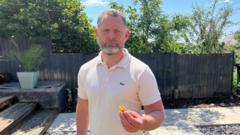Did Roy Whiting, Sarah Payne's Killer, Just Get Stabbed in Prison?

Understanding the Legal Proceedings: A Deep Dive into Roy Whiting's Case
The recent courtroom developments surrounding Roy Whiting, the notorious murderer of Sarah Payne, have raised numerous questions regarding prison safety, inmate interactions, and the legal implications of violent acts within correctional facilities. On February 11, 2023, Whiting found himself the target of an alleged attack by fellow inmate Andrew Light, who wielded a makeshift wooden shank. This incident, unfolding in the high-security environment of HMP Wakefield, highlights the complex dynamics of prison life and the ongoing risks even infamous convicts face. In this article, we will explore the details of the incident, the legal ramifications, and the broader implications for prison security and inmate welfare.
The Incident: A Timeline of Events
To understand the gravity of the situation, it's crucial to break down the events that transpired on that fateful day.
- 2:00 PM - 4:30 PM: The association period begins, allowing inmates to interact in a controlled environment.
- Inside Whiting's Cell: Whiting was in his single occupancy cell on D Wing, marking down his meals when Andrew Light entered.
- Initial Encounter: Light approached Whiting, confirming his identity before suddenly producing a homemade shank and launching an attack.
- Physical Confrontation: Whiting described a flurry of blows aimed at his head and neck, leading to a chaotic struggle.
- Guard Intervention: After a series of injuries, Whiting managed to alert guards, leading to Light's apprehension.
This timeline illustrates the rapid escalation from a mundane afternoon to a life-threatening encounter, underscoring the unpredictable nature of prison life.
Details of the Attack
Whiting's testimony reveals a harrowing account of his struggle for survival. Describing the attack, he recounted:
- The initial shock of being confronted by Light, whom he had never previously spoken to.
- The overwhelming force of the blows, which he attempted to deflect using his arms.
- The physical exhaustion he felt as he fought back, ultimately seeking refuge under his bed.
This brutal encounter raises significant concerns about inmate safety, particularly for high-profile prisoners like Whiting, who are often targeted by other inmates due to their notorious crimes.
Legal Proceedings and Charges
As the case unfolds in Leeds Crown Court, several key legal points have emerged:
- Charges Against Andrew Light: Light has admitted to possessing a bladed article in prison and pleaded guilty to unlawfully wounding Whiting. However, he denies attempted murder and wounding with intent.
- Prosecutor's Stance: Prosecutor Michael Smith emphasized that while Whiting is serving life for a heinous crime, the current case positions him as the victim, bringing a unique dynamic to the courtroom proceedings.
- Potential Sentencing Outcomes: If found guilty of attempted murder, Light could face significant additional prison time, compounded by his existing sentence for the wounding charge.
These legal intricacies illustrate the complexities of adjudicating violent incidents within prison settings and the challenges faced by the justice system in ensuring fairness for all parties involved.
The Impact on Prison Dynamics
The attack on Whiting raises broader questions about the safety of inmates and staff within correctional facilities. Here are some considerations:
- Inmate Safety: High-profile offenders often become targets for violence, necessitating enhanced protective measures.
- Prison Staff Training: Guards must be trained to recognize and respond to potential threats, ensuring timely intervention during violent incidents.
- Prison Design and Protocols: The layout and operational protocols of high-security prisons must prioritize inmate safety to prevent such attacks.
Addressing these issues is vital for maintaining order within prisons and ensuring the safety of both inmates and staff.
Psychological and Social Implications
The psychological effects of violent incidents in prison extend beyond immediate physical injuries. For Whiting, the trauma of this attack may linger, compounding the already complex emotional landscape of being a notorious criminal.
Emotional Toll on Victims
Survivors of violent attacks in prison often experience:
- Post-Traumatic Stress Disorder (PTSD): Many inmates may develop PTSD symptoms, including flashbacks, anxiety, and severe emotional distress.
- Isolation: Victims may feel isolated and mistrustful of others, leading to difficulties in forming relationships even with fellow inmates.
- Increased Vulnerability: The threat of further violence can lead to heightened paranoia and fear, impacting mental health.
Social Dynamics Among Inmates
Inmate interactions are often characterized by complex social hierarchies that can lead to conflict. Factors influencing these dynamics include:
- Reputation: Inmates with notorious backgrounds may attract unwanted attention from others, leading to jealousy, envy, or outright hostility.
- Power Struggles: The prison environment fosters competition for dominance, which can manifest in violent encounters.
- Gang Affiliations: Inmates may align with gangs that exert influence over others, creating an atmosphere of fear and intimidation.
Understanding these dynamics is essential for prison officials in creating a safe environment and addressing the underlying issues that lead to violence.
Conclusion: A Call for Reform
The brutal attack on Roy Whiting has highlighted the urgent need for reforms within the prison system. Ensuring the safety of inmates, particularly those with notorious backgrounds, requires a multifaceted approach that includes:
- Enhanced Security Protocols: Implementing stricter measures to prevent weapons from entering the prison.
- Training for Staff: Providing comprehensive training for prison guards to recognize signs of impending violence and respond effectively.
- Mental Health Support: Offering psychological support for inmates who have experienced violence, helping them cope with trauma.
As the trial continues, it serves as a reminder of the complexities surrounding crime, punishment, and rehabilitation. The legal system must navigate these challenges carefully to protect all individuals involved while upholding justice.
FAQs
What charges is Andrew Light facing?
Andrew Light is charged with possessing a bladed article in prison and unlawfully wounding Roy Whiting. He denies attempted murder and wounding with intent.
What was the nature of the attack on Roy Whiting?
Roy Whiting was attacked with a homemade wooden shank, resulting in multiple injuries to his face, neck, and stomach. He described the encounter as violent and chaotic.
How does prison violence affect inmates psychologically?
Inmates who survive violent attacks may experience PTSD, increased anxiety, and feelings of isolation, affecting their mental health and social interactions within the prison.
As this case unfolds, the implications extend far beyond the courtroom, raising critical questions about the safety and treatment of inmates in correctional facilities. How can the prison system be reformed to better protect the individuals it houses? #Justice #PrisonSafety #InmateRights
Published: 2025-06-23 19:34:00 | Category: News



